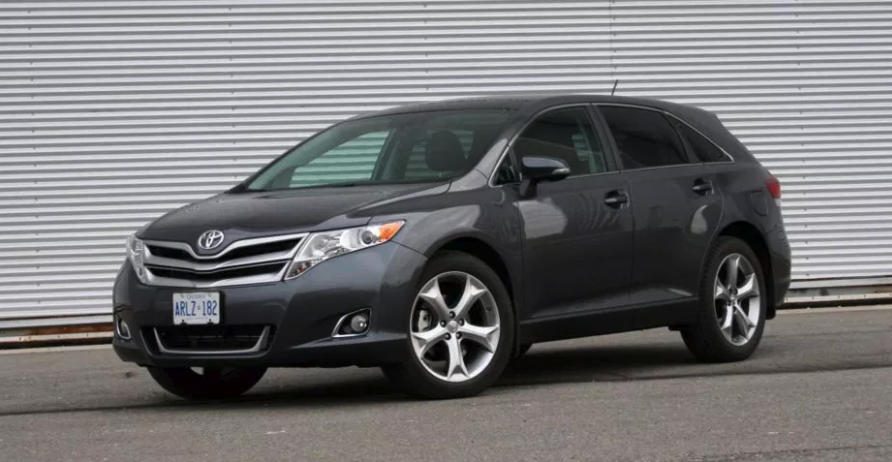Road Test: 2016 Toyota Venza

Story and photo by John LeBlanc
Created to fill the gap between its smaller RAV4 and the larger Highlander crossover siblings, the Toyota Venza has struggled to find a loyal fan base since its arrival in 2009. Even its maker was never sure what to make of the Venza. When it was introduced as a replacement for the first-generation, two-row Highlander, officials at Toyota could not bring themselves to call the Camry sedan-based Venza a crossover.
Toyota said the Venza was not a car, a station wagon nor an SUV, going as far as to say the Venza had “no direct competitors in the market … a new kind of vehicle … a segment buster,” clearly ignoring obvious rivals like the Ford Edge or Nissan Murano. Eight model years later, it seems like new vehicle buyers were equally confused about the five-passenger, midsize, four-door Toyota c-r-o-s-s-o-v-e-r.
In Canada last year, sales were less than half the over 13,000 sold in 2011 — the Venza’s best sales year ever. And that number pales to the over 10,000 Highlanders and over 42,000 RAV4s moved in 2015. In fact, due to its lack of sales, the Venza is no longer available in the U.S., the country it’s built in.
Popularity contests aside, there’s a lot to recommend about the $38,505 (base MSRP) 2016 Toyota Venza V6 AWD XLE Redwood Edition I drove for a week.
Pricing for the 2016 Venza starts with the front-wheel-drive, four-cylinder model at $30,465. Traction at all four wheels will cost an extra $2,200. If the base 2.7-litre four isn’t enough juice with 182 horsepower and 182 lb.-ft. of torque, the 3.5-litre six-cylinder (with AWD standard) delivers 268 horses and 246 lb.-ft. for $34,020.
Compared to similarly equipped V6 competition like the 2016 Ford Edge ($42,000) or 2016 Nissan Murano ($38,995), the Toyota is competitively priced. You can pay as much as $41,005 for a top-of-the-line Venza V6 AWD Limited, but our XLE tester offered a lot of value. Standard Venza XLE highlights include a navigation system, power rear hatch and a massive panoramic sunroof. The so-called Redwood Edition tester is a new version of the XLE for 2016, with the same $38,505 base price plus what Toyota says are some “unique redwood tones and distinctive leather seats” that jazz up an already roomy and practical cabin.
Much as it arrived in 2009, the Venza’s driving controls and instrumentation are clearly organized. The vehicle’s dash-mounted gear shifter is no gimmick; it’s in direct line with the natural arc of where a driver’s right-hand falls from the wheel. The Venza’s centre stack design is tilted forward for better sight lines. And its audio, heating and ventilation controls have all been logically separated, with buttons getting their own unique shapes.
Because of its generous width, the Venza ends up being one of the roomier two-row crossovers you can buy — much appreciated when you need to don your parka for winter driving. And rear-seat legroom is especially generous, right in line with its Ford and Nissan rivals.
At 870 litres, the Toyota’s seats-up rear cargo space is more than the Nissan, less than the Ford. However, compared to the newer Edge and Murano, the Venza’s interior feels less expensive, with rough-hewn plastics and several trim pieces not aligned.
With Toyota’s ubiquitous V6 and six-speed automatic powertrain, the Venza always feels relaxed, smooth and fast. It also delivers in the towing department with a capacity of 1,587 kilograms — more than twice as much as the Murano.
With Camry nuts and bolts underneath, overall, the Venza drives very car-like. The Toyota crossover’s wide, low stance and large wheels mean it doesn’t sit tall. From the driver’s seat, the Toyota corners relatively flat. While we enjoyed the Venza’s pliable suspension — it eats potholes for breakfast, lunch and dinner — there was always a lot of road and tire noise creeping into its cabin.
One reason why the Toyota is a bit less expensive than some of its rivals is its lack of state-of-the-art driving aids or safety gear. Features that are becoming common in this segment, like lane departure warning, blind spot alert or dynamic cruise control systems, are nowhere to be found on the Venza’s options list. That alone prevents the Toyota from being an “excellent” instead of just a “good” value.
But if you need a roomy, comfortable midsize crossover that tows well, the 2016 Toyota Venza may be an underrated option you forgot about.
Keen drivers will need to look elsewhere for kicks behind the wheel. The Toyota’s steering offers little feedback, leaving the driver guessing what’s going on at road level. The other big strike against the Venza is its front seats. Neither comfortable nor supportive, drivers will be constantly shifting around to find a position that doesn’t cause a trip to the chiropractor after an hour.





![[del.icio.us]](https://www.straight-six.com/wp-content/plugins/bookmarkify/delicious.png)
![[Digg]](https://www.straight-six.com/wp-content/plugins/bookmarkify/digg.png)
![[Facebook]](https://www.straight-six.com/wp-content/plugins/bookmarkify/facebook.png)
![[Google]](https://www.straight-six.com/wp-content/plugins/bookmarkify/google.png)
![[Reddit]](https://www.straight-six.com/wp-content/plugins/bookmarkify/reddit.png)
![[StumbleUpon]](https://www.straight-six.com/wp-content/plugins/bookmarkify/stumbleupon.png)
![[Twitter]](https://www.straight-six.com/wp-content/plugins/bookmarkify/twitter.png)
![[Email]](https://www.straight-six.com/wp-content/plugins/bookmarkify/email.png)